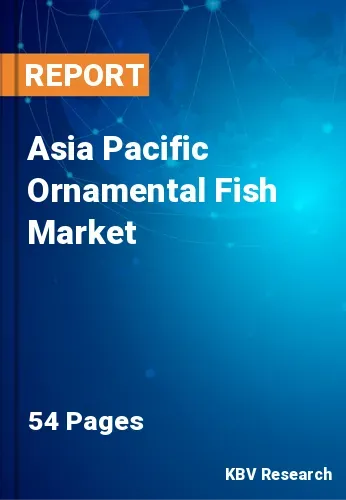The Asia Pacific Ornamental Fish Market would witness market growth of 8.6% CAGR during the forecast period (2022-2028).
It is well known that watching ornamental aquatic species float serenely over the water has a calming and relaxing impact on people. Many young consumers have been seen to prefer purchasing attractive fish species primarily for ornamental purposes due to their enticing traits and unique attributes. As a result, the ornamental fish market has grown at an exponential rate. Furthermore, recent technical improvements in the sector, such as pet cams and automatic filtration, have increased the demand for pet adoption. For example, monitoring aquarium water chemistry has always been a worry, but modern in-tank equipment can now provide real-time measurements for everything from pH levels to water hardness, making it much easier to maintain optimal conditions.
In comparison to huge food-fish production operations, aquarium fish production facilities are frequently modest. Fish are primarily raised in small-large tanks and outdoor ponds, with many small tanks and aquaria housed indoors. The growth of ornamental fish in indoor facilities employing water-recirculation systems is gaining popularity. Indoor cultivation takes advantage of recent advances in husbandry practices and water filtering technologies. By preventing the migration of farmed fish and reducing water use, ornamental fish farming in indoor facilities utilizing water-recirculating devices can further reduce any potential environmental impact. The small-scale character of an ornamental fish farming system, whether outdoors or indoors, reduces the environmental effect and maximizes the utilization of land, labor, capital, and operational costs.
Each year, a large number of ornamental fishes are imported into Australia for stocking into household aquaria or garden ponds, and it is estimated that between 12 and 14 percent of Australians keep aquaria. Some of these ornamental fish would inevitably end up in natural waterways, and while many would perish, some would develop wild populations. As a result, over the last 20-30 years, the number of foreign freshwater ornamental fish species establishing wild populations in Australia has increased. Up to 30 of the 41 alien fish species presently known to have established populations in Australia are considered to have arrived via the ornamental fish trade.
India's inland and marine waters are home to a diverse range of ornamental fish, with over 195 indigenous types documented from the North-East and the Western Ghats, and approximately 400 species from marine habitats. The most important fish exported from India are wild species taken from rivers in the North-East and Southern States, which account for roughly 85% of the country's total decorative fish exports.
The China market dominated the Asia Pacific Ornamental Fish Market by Country in 2021, and would continue to be a dominant market till 2028; thereby, achieving a market value of $672.6 million by 2028. The Japan market is experiencing a CAGR of 8% during (2022 - 2028). Additionally, The India market would exhibit a CAGR of 9.3% during (2022 - 2028).
Based on Application, the market is segmented into Commercial and Household. Based on Product, the market is segmented into Tropical Freshwater, Temperate, and Marine. Based on countries, the market is segmented into China, Japan, India, South Korea, Singapore, Malaysia, and Rest of Asia Pacific.
Free Valuable Insights: The Worldwide Ornamental Fish Market is Projected to reach USD 8.6 Billion by 2028, at a CAGR of 8%
The market research report covers the analysis of key stake holders of the market. Key companies profiled in the report include Aqua-Nautic Specialist Pte Ltd., AlgaeBarn, LLC, bioAquatiX, Imperial Tropicals, Oasis Fish Farm, Sanyo Aquarium (Pte) Ltd., Qian Hu Corporation Limited, Sunbeam Aquarium Pte Ltd., and Tropical Fish International Pte Ltd.
By Application
By Product
By Country

Our team of dedicated experts can provide you with attractive expansion opportunities for your business.

